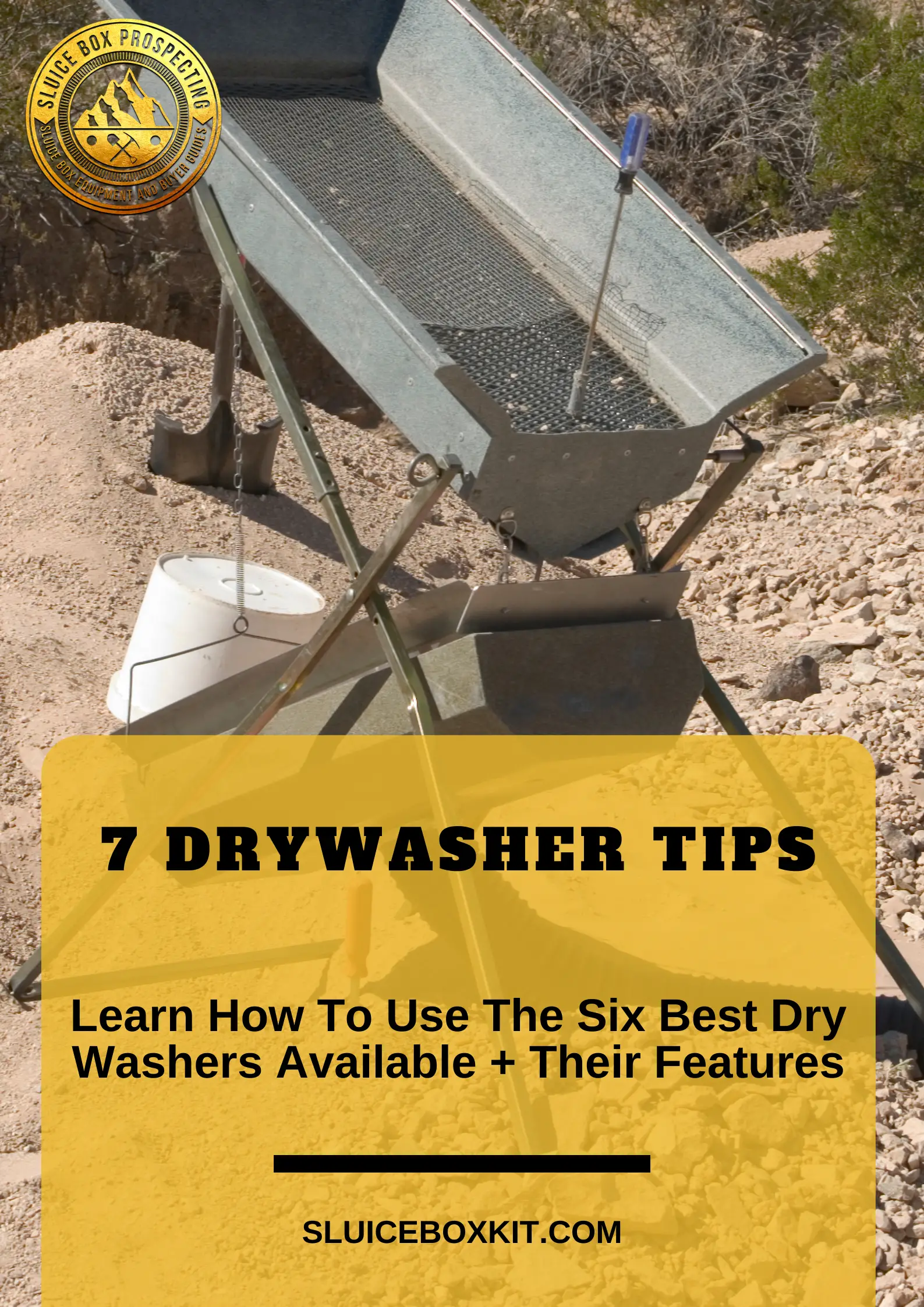A drywasher is a machine that uses air to separate the gold from the dirt. This blog post will discuss how dry washing works and some of the best dry washers. We’ll also give you some tips on using one to find more gold!
Dry washing for gold has been around for a long time, and it is one of the most efficient ways to find gold in arid or desert areas. A drywasher allows you to separate the gold from the dirt without water. This feature is essential because water is scarce in dry areas.
What Is A DryWasher?
Table of Contents
A drywasher is similar to a highbanker; only it uses air to separate the gold from the dirt instead of water. The dry washer is essentially a large, powerful fan that blows air through the material.
Dry washing is most effective in areas with little or no water. You can use dry washers in dry, desert areas. They are also popular in areas where traditional gold panning and prospecting methods are not possible, such as steep slopes or rocky terrain.
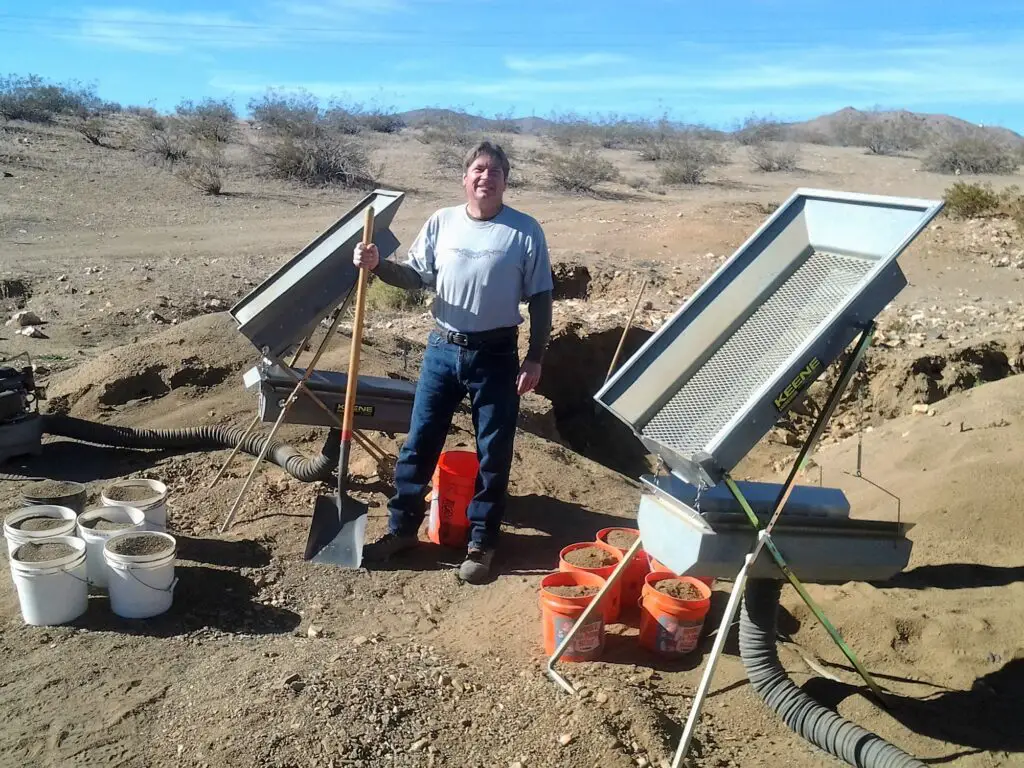
source: keeneng.com
How Does A DryWasher Work?
A drywasher works using air to separate the gold from the dirt without water. The machine uses a blower to suck in air and blow away the lighter materials, like dirt and rocks within the hopper, and then passes through the loading gate to separate further using riffles in the recovery box.
The forced air from dry washing knocks the gold loose from the dirt and collects it in a catchment area as the air passes through it. The gold is left behind because it is heavier than the other materials as it becomes trapped within the riffles of the sluice.
The earliest models were hand-operated and used bellows to puff air across a series of riffles to catch the gold, while lighter material would go over the riffles and onto the ground. Today, many dry washers are powered by a small blower motor, which provides a constant flow of air that moves a counterweighted fan that shakes the whole apparatus, allowing gold to separate from the lighter materials. – goldrushnuggets.com
Setting up a dry washing machine is relatively simple. Like a river sluice, you will need to shovel dirt into the hopper. The dry washer will separate the gold from the dirt and collect it in a catchment area as it pulsates air with concise, powerful gusts into the material.
After running several loads of dirt, it is best to use a wet gold pan to determine if gold is surfacing in your digging location. Many prospectors also place a fine screen atop the riffles to further classify the materials like you typically would with a wet sluice.
How Do You Set Up A Dry Washing Machine?
The drywasher consists of a frame that supports all the components. There are six components of a dry washer:
- The engine or blower
- A Loading Hopper
- An Angle Adjustment Chain
- The Flow Gate
- A Recovery Box (sluice box)
- The Standing Frame
The engine or blower is typically gas-powered and provides the airflow necessary to move material through the dry washer—the hopper filters out the larger rocks and debris before reaching the recovery box.
The recovery box is where the gold is collected. It has a series of riffles that catch the gold passing through the clarifier. The flow gate helps control the speed of materials entering the recovery box by adjusting the opening size.
You will also need a dry washing pan to help you work the material and separate the gold from the lighter materials.
What Are The Best Dry Washers For Finding Gold?
First and foremost, you want a durable dry washer that can withstand the rigors of prospecting. You also want one with a large hopper to process more material at a time. The dry washer should also be easy to set up and use so that you can get to work quickly.
6 Best Best Dry Washers On The Market:
- Royal King Dry Washer
- Keene 151S Vibrostatic
- Keene Hand Crank Mini
- Keene 140S Portable (Backpack)
- Thompson Drywasher (out of stock)
- Gold Buddy Dry Washer (out of stock)
The Royal King Dry Washer
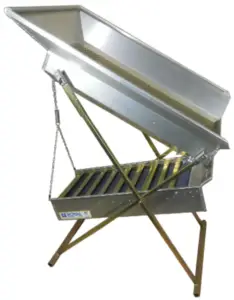
The Royal dry washer is a durable and well-built dry washer perfect for the serious prospector. It features a large hopper so that you can process more material at a time, and it is easy to set up and use. The Royal King dry washer is an excellent choice for those who want to find gold in dry, desert areas.
The setup has a feeding rate of up to 1 ton per hour. It is a great choice for those who want to process a lot of material quickly. The dry washer is also easy to set up and use. The Hopper is fully enclosed, so no large rocks get in under the classifier clogging your adjustable flow valve.
The hopper is huge for simple feeding at 40″ X 27″ and contains 143 rivets. This unit is a more durable, stronger product due to its use of 167 rivets. All steel components are zinc plated for extra durability. The Hopper positions at a working height of 56″. This unit weighs 49 pounds.
Keene 151S Vibrostatic
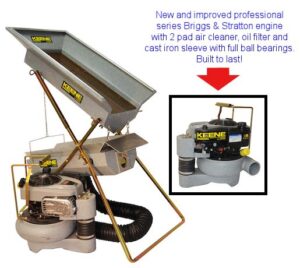
The Keene 151s V dry washer is another great choice for those who are serious about prospecting. It is a durable drywasher with a large hopper that can process more material at a time. The Keene dry washer is easy to set up and use, and it features a vibrating function that helps separate the gold from the lighter materials.
The new features of the Keene 151S include “Soft Bed Technology,” which creates a sturdier electrostatic charged recovery bed, and “Scrubbing Pins,” which allow for early gold classification and even flow before entering the recovery tray.
The air is “preheated” up to 50 degrees Fahrenheit above ambient temperature and introduced into the radial blower to aid in drying wet material. For better gold production, the 151S has a vibratory action to help to stratify the material and separate the gold.
The Keene 151S is one of the most popular drywashers on the market, and for a good reason. The legs of the folding support have “vibration transfer brackets,” which transfer energy to the hopper for more complete and efficient classification.
The folding support legs and the 10 feet of heavy-duty 4-inch ducting hose included with this machine make this model a cinch to assemble. The hopper is larger with steeper sides to make room for more volume and avoid material accumulation.
It Weight 99 lbs and typically includes a 5 HP Briggs & Stratton stock engine. The radial blower is rated 4″ x 2000 CFM. The discharge vinyl hose is 10′ x 4″.
The Keene 151S V has a feeding rate that can exceed 2 tons per hour. It is one of the most popular dry washers on the market because of its easy setup, usability, and durability.
Keene Hand Crank Mini
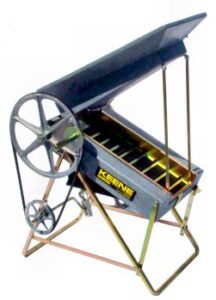
The Keene Hand Crank Mini is a lightweight, compact, portable, and efficient dry washer. The hand-turned crank controls vibration, allowing heavier materials to settle faster.
The big Marlex hopper has an adjustable flow valve for a uniform material flow with increased capacity. The dual riffle design improves fine gold recovery substantially and includes an easy-to-use snap latch that makes removing the riffle tray a breeze.
It has a sturdy black Marlex plastic hopper with a steel frame. An adjustable flow control gate is included in the large hopper.
The vibrating camshaft and bellows aid the recovery of even the tiniest gold. The machine is 42″ tall, and the detachable recovery tray is 8-1/2″ x 20″. The hand-crank model weighs only 32 pounds. The conversion kit to convert from 12 volts to 24 volts adds 8 pounds.
The gravel material should be as dry as possible to operate efficiently. There is no need to prescreen the gravels before going into the concentrator because the expanded metal grizzly efficiently classifies the material before entering the recovery sluice.
The heavier material will settle and flow down into the riffle tray due to the vibrating camshaft to capture the heavier gold particles.
The Keene 140S
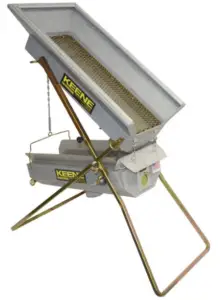
The Keene 140S is ideal because of its adjustable oscillating vibrator and flow gate settings. Thanks to the large feed hopper, it can produce up to 3/4 cubic yards per hour, which may store up to 2 1/2 gallons of material.
You can also use a leaf blower or the “Vac Pack” system to operate this concentrator. This super lightweight (20 lbs.) concentrator is simple to set up without using any equipment and fits into an 11″ x 21″ x 31″ package that may be attached to the Deluxe Back Pack (BP4).
- 41.5″ tall when completed is the maximum height of the system when all components are in place.
- The overall length of the top hopper is 29″ x 15.5″
- The Hopper classifier has a 24-inch screen length and a 9-inch width.
- Overall length and width of the riffle tray: 29 inches x 9.5 inches
- Folding dimensions: 23″ x 21″ x 15″
The Keene 140S is simple to put together, requiring no tools. Adjustable vibrating speeds. Riffle design for any gravel conditions with a twin-action action.
10 Benefits Of Using A Dry Washer For Gold Prospecting
- Excellent for recovering gold in dry, desert conditions
- Lightweight and portable, so they can be easily moved around
- Require no water, so they are perfect for areas where water is scarce
- Easy to set up and use
- Low maintenance and easy to operate
- Useful in remote areas where there is no water available
- Very efficient at recovering gold
- Versatile in various terrain and conditions
- Relatively inexpensive compared to other gold prospecting equipment options.
A dry washer is an excellent option if you’re prospecting in an area where water is scarce or want to minimize your impact on the environment. Dry washers are ideal for any gold prospector with easy setup, operation, and maintenance.
When operating a dry washer, it is essential to remember that the material needs to be as dry as possible. If the material is too wet, it will not work effectively. Here are some tips and tricks for using a dry washer:
7 Tips For Successfully Using A DryWasher
- Make sure the material you are using is dry. You can dry it out if it is not by spreading it out in the sun or with the blower.
- Test the material from the recovery box after placing the first initial loads into the hopper to verify if your location is worthwhile
- Before you throw away your rocks, double-check that they’re all the “throwaway” type.
- Metal detecting them is a fantastic approach to ensuring you’re not throwing away golden-laden pebbles.
- On abandoned mining sites, use your detector when searching for old tailings. These inconspicuous stones might be full of gold, but previous prospectors completely overlooked them.
- Areas with the most erosion generally have the greatest concentration of gold values.
- The best regions to search for gold are where the hills meet the desert and eventually flatten. Areas like this allow water from storms to deposit gold in the washouts.
Dry washing for gold is an effective and efficient method for prospecting in areas where water is scarce. With some tips and tricks, you can be on your way to finding gold in no time.
- There are a few cautionary items to be aware of while using a dry washer:
- drywashers can be less efficient than other methods of gold prospecting (such as panning or slicing) because they lose a lot of fine gold through the vibration process
- materials in the dry washer can be blown away by strong winds, making them less effective in windy conditions
- dry washers typically have a lower capacity than other methods of gold prospecting
Overall, dry washers are an effective and efficient tool for gold prospecting in dry, desert conditions. They are easy to set up and use, require no water, and are low maintenance. They can be used in remote areas with no water available and efficiently recover gold.
Drywashers are also relatively inexpensive compared to other gold prospecting equipment options. If you are looking for a way to find gold in dry, desert conditions, a dry washer is a great option.

